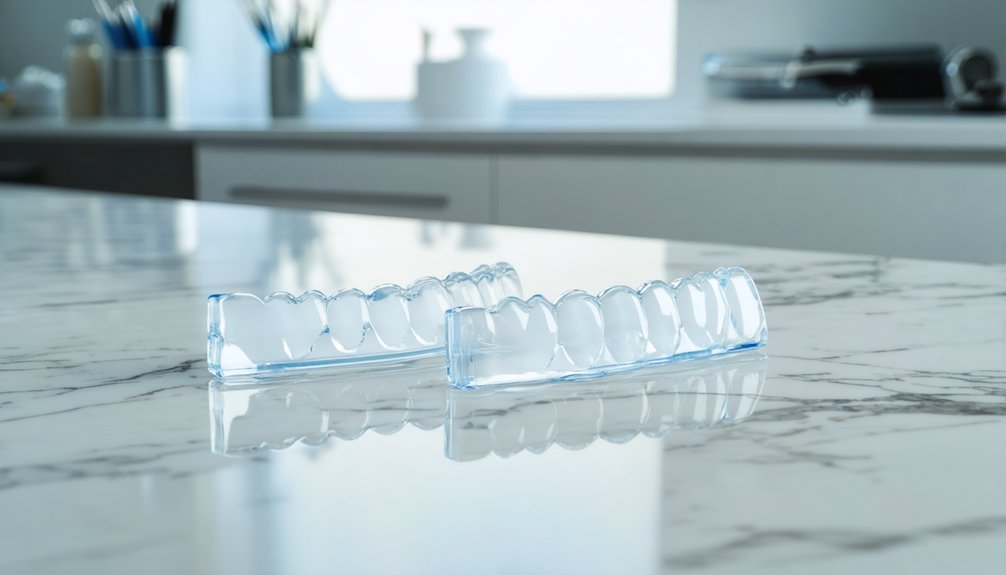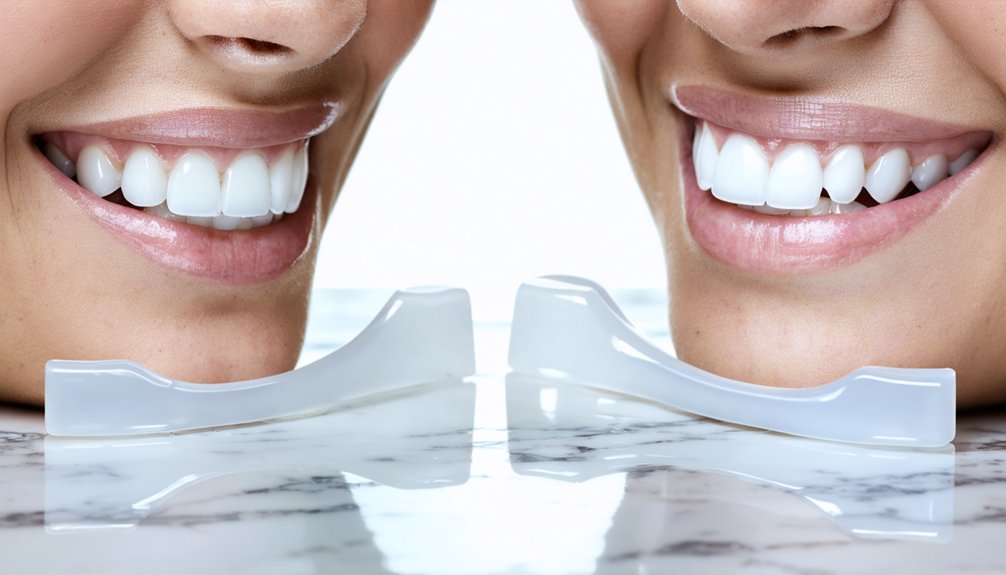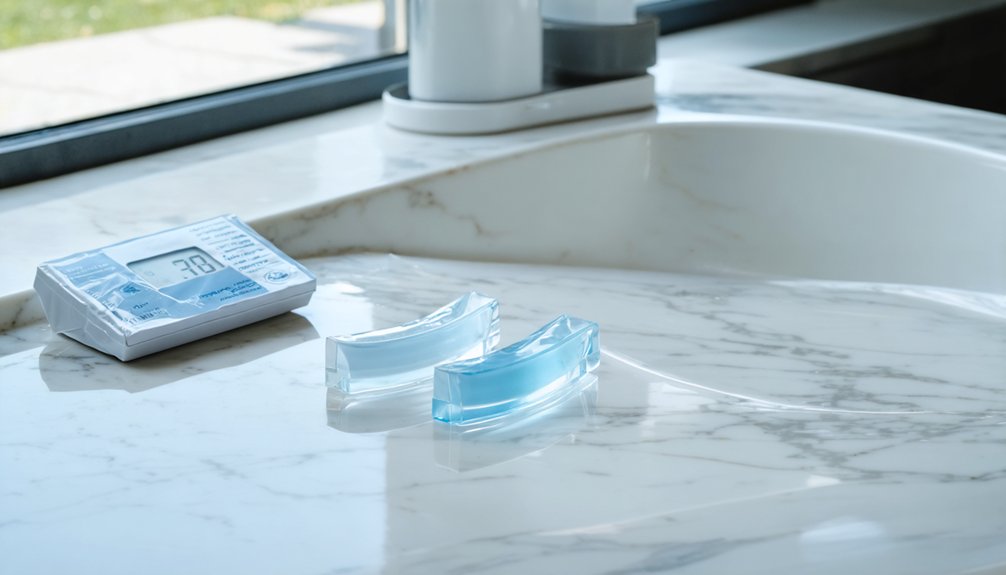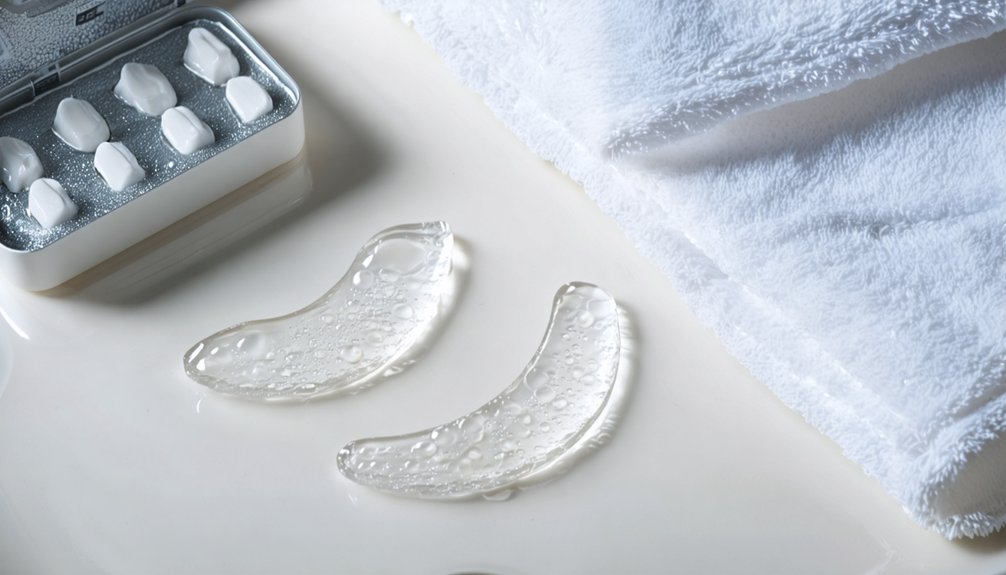Hydrogen peroxide whitening strips offer you clinically proven, professional-grade results through their advanced oxidation process. You’ll see measurable improvements within 7-21 days as the active oxygen molecules penetrate your enamel to break down both surface and deep-seated stains. With proper application, these strips deliver ΔE values exceeding 4.7, surpassing visible whitening thresholds, while maintaining a strong safety profile. The documented efficacy and cost-effectiveness of this scientifically validated approach warrant closer examination of its extensive benefits.
Key Takeaways
- Clinically proven effectiveness with visible whitening results in 7-21 days, lasting up to 18 months with proper maintenance.
- Easy at-home application requiring only 5-30 minutes daily, making it convenient to incorporate into regular routines.
- Cost-effective alternative to professional treatments while delivering comparable whitening results of 1-2 shades improvement.
- Safe for regular use with minimal side effects when used as directed, backed by ADA acceptance standards.
- Effectively treats both surface-level and deep-seated stains through peroxide’s ability to penetrate tooth enamel.
The Science Behind Peroxide-Based Whitening
The oxidation process of hydrogen peroxide (H₂O₂) forms the cornerstone of modern teeth whitening technology. When you apply whitening strips to your teeth, the H₂O₂ initiates a sophisticated mechanism of action that penetrates both enamel and dentin layers.
The peroxide molecules break down into water and reactive oxygen species, targeting chromophores – the compounds responsible for tooth discoloration. The American Dental Association recommends using products with concentrations up to 3.5% for safe and effective whitening results. Unlike ancient Roman methods, modern peroxide-based treatments are both hygienic and scientifically proven.
Through enamel penetration, these active oxygen molecules effectively dismantle complex stain compounds into simpler, colorless structures. The process works on both surface-level (extrinsic) and deep-seated (intrinsic) stains, offering thorough whitening results.
Heat and light can accelerate this chemical reaction, which explains why professional treatments often incorporate these catalysts to enhance the whitening process’s efficiency.
Clinical Studies Support Superior Results
Multiple randomized controlled trials confirm that you’ll see significant tooth color improvement within 7-21 days of using hydrogen peroxide whitening strips, with more than 80% of these results lasting up to 18 months post-treatment.
Clinical research demonstrates that 6-6.5% hydrogen peroxide strips consistently outperform other over-the-counter whitening products due to superior peroxide concentration and enhanced tooth contact time.
Spectrophotometric analysis reveals that these strips produce ΔE values exceeding 5, indicating substantial visible whitening effects that match professional-grade treatments.
While OTC whitening products may be convenient, research shows they often provide limited whitening effectiveness compared to professional treatments, especially in terms of long-term color stability.
Unlike most OTC products that only remove surface stains, hydrogen peroxide strips can penetrate tooth tissues to address intrinsic stains effectively.
Proven Color Change Results
Extensive clinical studies validate the superior whitening efficacy of hydrogen peroxide strips through rigorous randomized controlled trials. The data demonstrates significant color change effectiveness, with measurable improvements visible within 7-21 days of use.
Digital analysis confirms whitening strip technology achieves ΔE values exceeding 4.7 – well above the visually perceptible threshold of 2.0. You’ll find these results are both substantial and long-lasting, with over 80% of initial whitening maintained even after 18 months.
Clinical measurements using spectrophotometry and standardized imaging verify consistent performance across diverse populations and usage patterns. The strips’ barrier design guarantees ideal peroxide contact time, delivering superior results compared to other OTC options like paint-on gels or rinses.
This scientifically-proven efficacy makes hydrogen peroxide strips a reliable choice for professional-grade whitening outcomes.
Fast Visible Improvement
Clinical studies consistently demonstrate rapid whitening effects within the first week of hydrogen peroxide strip use, achieving ΔE values between 2.78 and 7.71 after initial 30-minute applications.
You’ll notice visible differences after just one day, with continued improvement throughout treatment. These rapid results are scientifically validated through spectrophotometry and digital imaging analysis.
The strips’ fixed barrier design guarantees consistent peroxide contact with your enamel, delivering superior outcomes compared to paint-on gels or whitening toothpaste.
Clinical trials confirm these fast-acting benefits across diverse populations worldwide, regardless of age, diet, or oral care habits.
You can confidently recommend these strips to patients seeking professional-grade whitening results, knowing they’re achieving measurable improvements while maintaining ideal oral health through controlled 30-minute applications.
Research-Backed Treatment Outcomes
While other whitening methods show mixed results, hydrogen peroxide strips consistently demonstrate superior efficacy with mean ΔE values of 4.73 – more than double the threshold for visible color change.
Clinical studies validate treatment satisfaction across diverse populations, with color improvements ranging from ΔE 2.78 to 7.71 after just 30 minutes of use.
You’ll achieve better whitening efficacy with these strips compared to other OTC options like bromelain or sodium bicarbonate.
Research confirms that higher peroxide concentrations deliver prime results, especially in younger patients with significant discoloration.
The strips’ barrier-enhanced design guarantees prolonged contact with your teeth, matching the effectiveness of custom tray treatments.
Digital imaging analysis proves that over 80% of initial whitening persists after 18 months, demonstrating reliable, long-lasting outcomes for your patients.
Easy At-Home Application Process
Thanks to advances in dental technology, hydrogen peroxide whitening strips offer a straightforward and efficient application process that you can complete at home without professional supervision.
Most strips are safe for ages 12+ when following the instructions carefully. You’ll find these strips require just 5 to 30 minutes of wear time, depending on their strength, with applications once or twice daily.
To maximize your whitening results, avoid using fluoride toothpaste before application. Simply align the strips with your gum line and fold them behind your teeth for complete coverage. Dry your teeth thoroughly before applying the strips for optimal adhesion.
The process integrates seamlessly into your daily routine, whether after breakfast or before bedtime. Since whitening strips don’t require special equipment or messy trays, you’ll appreciate their portability and minimal cleanup.
Whitening strips fit easily into your everyday schedule, offering hassle-free teeth whitening without the need for complicated tools or cleanup.
This convenient application method delivers professional-grade results while maintaining your busy schedule.
Safety Profile and Common Side Effects

You’ll find that hydrogen peroxide whitening strips demonstrate a well-documented safety profile when used as directed, with clinical studies showing minimal risks comparable to placebo treatments.
The most common side effects you might experience include transient tooth sensitivity (affecting about 10% of users) and mild gingival irritation, both of which typically resolve upon discontinuation or reduced exposure. Professional whitening treatments can use higher concentrations of up to 40% hydrogen peroxide.
The American Dental Association‘s acceptance program has validated these products’ safety standards, confirming that proper use of approved whitening strips poses minimal risk while delivering effective results. The whitening process occurs through oxidation of chromophores as the peroxide penetrates the enamel and dentin layers.
Manageable Side Effect Profile
Although hydrogen peroxide whitening strips can cause temporary side effects, clinical studies demonstrate a highly manageable safety profile with minimal risks when used as directed.
Tooth sensitivity management is straightforward, affecting only about 10% of users with 6% peroxide strips over long-term use. You’ll find that gum irritation prevention is achievable through proper strip placement and adherence to recommended exposure times.
Clinical trials comparing 6% peroxide strips to placebos over 12 months show comparable safety profiles with no significant increase in adverse events.
The strips’ targeted delivery system minimizes soft tissue contact while allowing sufficient whitening action. You can further reduce sensitivity risks by following the prescribed short daily applications rather than extended single treatments, ensuring ideal results with minimal discomfort.
ADA-Supported Safety Standards
While hydrogen peroxide whitening strips offer effective tooth bleaching, the American Dental Association (ADA) has established strict safety standards to assure consumer protection.
Following ADA guidelines, concentrations of ≤3.5% hydrogen peroxide are deemed safe for over-the-counter whitening products. The ADA Seal of Acceptance guarantees these products meet rigorous safety protocols and efficacy requirements.
The dramatic rise in teeth whitening popularity during the COVID-19 pandemic sparked increased consumer interest in at-home treatments.
You’ll experience peak results and minimize risks when using whitening strips under professional dental supervision.
While temporary tooth sensitivity and mild gum irritation may occur, these effects typically resolve after treatment completion. The ADA confirms that whitening strips won’t compromise your enamel integrity when used as directed.
However, if you have dental restorations, consult your dentist first, as peroxide can affect restoration materials differently.
Always follow manufacturer instructions and your dentist’s recommendations for safe, effective whitening.
Cost-Effective Professional-Grade Results
Despite the higher cost of professional dental whitening treatments, hydrogen peroxide whitening strips deliver comparable results at a fraction of the price. Clinical studies demonstrate that these affordable options can achieve 1-2 shade improvements through consistent user experiences, particularly effective for common extrinsic stains from coffee, tea, and smoking. With proper application, users can expect to see noticeable results within days while following the recommended treatment schedule.
- Advanced adhesion technology guarantees prolonged peroxide contact with tooth surfaces
- Controlled concentrations of 5-14% hydrogen peroxide provide ideal whitening efficiency
- LED-enhanced strips amplify whitening action to approach professional-grade results
- No specialized equipment or dental visits required, reducing overall treatment costs
- Achieves comparable outcomes to supervised home bleaching kits while minimizing sensitivity risks
The combination of targeted peroxide delivery and enhanced adhesion technology makes these strips a cost-effective alternative to expensive in-office procedures, without compromising on whitening efficacy.
Treatment Duration and Expected Outcomes

Understanding the ideal treatment timeline maximizes the effectiveness of hydrogen peroxide whitening strips. You’ll typically need 7-14 days of consistent use to achieve optimal outcomes, with initial improvements visible within the first few days.
The treatment timing depends on maintaining proper contact between the strips and your teeth for 5-60 minutes daily. Your expected results can last 6 months to a year, though this varies based on lifestyle factors.
Daily treatments of 5-60 minutes with proper strip contact can deliver whitening results lasting 6-12 months, depending on your habits.
You’ll need to protect your investment by avoiding staining agents like coffee and red wine. For sustained whitening, implement a maintenance protocol with periodic touch-ups every few months.
Remember that sensitivity may occur, so don’t exceed recommended treatment durations. If you experience discomfort, taking brief breaks won’t compromise your progress while ensuring safe, effective whitening.
Comparing Different Whitening Methods
Among available teeth whitening options, hydrogen peroxide strips represent a scientifically validated method that combines efficacy with convenience.
When comparing whitening effectiveness, peroxide-based strips consistently outperform natural alternatives like sodium bicarbonate and bromelain. You’ll find these strips deliver results comparable to professional tray treatments, often achieving noticeable shade changes more rapidly than other over-the-counter methods.
- Delivers targeted peroxide application through advanced adhesive technology
- Provides faster results than paint-on gels or ready-to-use tray systems
- Matches professional-grade outcomes in controlled studies
- Maintains consistent contact with tooth surfaces for peak effectiveness
- Surpasses natural alternatives in both speed and degree of whitening
The superior performance stems from the strips’ ability to maintain prolonged contact between the active peroxide ingredient and tooth enamel, maximizing the chemical whitening process while minimizing waste.
Best Practices for Optimal Results

To achieve maximum whitening effectiveness with hydrogen peroxide strips, proper preparation and application techniques are essential.
Begin by gently brushing to remove plaque and debris, then wait 30 minutes to minimize sensitivity. Confirm your teeth are completely dry before proceeding with application tips that maximize results.
When applying strips, align them precisely with your gum line and press firmly to eliminate air pockets. Avoid common mistakes such as overlapping strips or leaving them on longer than recommended.
You’ll need to wear them for 20-60 minutes, depending on product specifications.
Post-treatment, rinse thoroughly and wait at least 30 minutes before consuming food or beverages. If sensitivity occurs, use desensitizing toothpaste and warm saltwater rinses to soothe any gum irritation.
Who Should Consider Peroxide Strips
While hydrogen peroxide whitening strips offer an effective at-home solution for many users, they’re particularly suited for individuals with extrinsic tooth stains and good oral health.
As ideal candidates, you’ll achieve best results if you’re committed to following the prescribed treatment protocol and have realistic whitening expectations. Professional evaluation confirms these strips work best for surface stains from coffee, tea, or tobacco use.
- You have healthy teeth and gums without active decay or disease
- You’re seeking a cost-effective alternative to professional treatments
- You can consistently follow application instructions
- You have extrinsic stains rather than deep intrinsic discoloration
- You’re willing to maintain regular oral hygiene practices during treatment
These criteria help guarantee your safety and maximize the effectiveness of peroxide whitening strips as part of your dental care routine.
Frequently Asked Questions
Can Whitening Strips Be Used While Wearing Clear Aligners or Retainers?
You shouldn’t use whitening strips with aligners due to poor aligner compatibility and interference with tooth movement. However, certain retainers may offer retainer safety when used with dentist-approved whitening gels.
How Long Do Whitening Results Typically Last Before Requiring Touch-Up Treatments?
You’ll typically maintain long lasting effects for 6-12 months before requiring touch-up treatments. Your specific results depend on diet, oral hygiene habits, and lifestyle factors affecting stain accumulation.
Will Peroxide Strips Work on Teeth With Dental Bonding or Veneers?
Just as oil and water don’t mix, peroxide strips won’t whiten bonding materials or veneers. You’ll notice uneven results since these dental restorations maintain their original shade while natural teeth whiten.
Can I Drink Coffee or Wine Immediately After Using Whitening Strips?
You shouldn’t drink coffee or wine immediately after whitening strips. Following whitening strip guidelines, wait at least 30-60 minutes, as your enamel’s temporarily porous state increases beverage staining effects.
Should Whitening Strips Be Used Before or After Brushing Teeth?
You’ll maximize whitening effectiveness by brushing first, but wait 30 minutes before applying strips. Don’t rush – your oral hygiene matters more than your desperate quest for pearly whites.
References
- https://dentistry.llu.edu/sites/dentistry.llu.edu/files/2022-11/2022-opd-whitening-strips.pdf
- https://www.genesispub.org/resource/images/articles/pdf520.pdf
- https://www.healthline.com/health/do-whitening-strips-work
- https://www.frontiersin.org/journals/dental-medicine/articles/10.3389/fdmed.2021.687507/full
- https://pubmed.ncbi.nlm.nih.gov/19233534/
- https://www.drjosephstandds.com/blog/are-teeth-whitening-strips-safe/
- https://pubmed.ncbi.nlm.nih.gov/19523738/
- https://pubmed.ncbi.nlm.nih.gov/22925924/
- https://www.gentledental.com/resources/articles/hydrogen-peroxide-teeth-whitening
- https://www.mcgill.ca/oss/article/health-you-asked/how-does-peroxide-whiten-teeth



